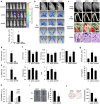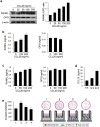Human antigen R-regulated CCL20 contributes to osteolytic breast cancer bone metastasis
- PMID: 28851919
- PMCID: PMC5575024
- DOI: 10.1038/s41598-017-09040-4
Human antigen R-regulated CCL20 contributes to osteolytic breast cancer bone metastasis
Abstract
Breast cancer mainly spreads to bone, causing decreased survival of patient. Human antigen R (HuR) and chemokines are important molecules associated with mRNA stability and cell-cell interaction in cancer biology. Here, HuR knockdown inhibited bone metastasis and osteolysis of metastatic breast cancer cells in mice and HuR expression promoted the metastatic ability of cancer cells via CCL20 and GM-CSF. In contrast with the findings for GM-CSF, ELAVL1 and CCL20 expressions were markedly increased in breast tumor tissues and ELAVL1 expression showed a strong positive correlation with CCL20 expression in breast cancer subtypes, particularly the basal-like subtype. Metastasis-free survival and overall survival were decreased in the breast cancer patients with high CCL20 expression. We further confirmed the role of CCL20 in breast cancer bone metastasis. Intraperitoneal administration of anti-CCL20 antibodies inhibited osteolytic breast cancer bone metastasis in mice. Treatment with CCL20 noticeably promoted cell invasion and the secretion of MMP-2/9 in the basal-like triple-negative breast cancer cell lines, not the luminal. Moreover, CCL20 elevated the receptor activator of nuclear factors kappa-B ligand/osteoprotegerin ratio in breast cancer and osteoblastic cells and mediated the crosstalk between these cells. Collectively, HuR-regulated CCL20 may be an attractive therapeutic target for breast cancer bone metastasis.
Conflict of interest statement
The authors declare that they have no competing interests.
Figures






Similar articles
-
15-deoxy-δ12,14-prostaglandin j2 inhibits osteolytic breast cancer bone metastasis and estrogen deficiency-induced bone loss.PLoS One. 2015 Apr 10;10(4):e0122764. doi: 10.1371/journal.pone.0122764. eCollection 2015. PLoS One. 2015. PMID: 25859665 Free PMC article.
-
NF-kappaB in breast cancer cells promotes osteolytic bone metastasis by inducing osteoclastogenesis via GM-CSF.Nat Med. 2007 Jan;13(1):62-9. doi: 10.1038/nm1519. Epub 2006 Dec 10. Nat Med. 2007. PMID: 17159986
-
Sclerostin induced tumor growth, bone metastasis and osteolysis in breast cancer.Sci Rep. 2017 Sep 12;7(1):11399. doi: 10.1038/s41598-017-11913-7. Sci Rep. 2017. PMID: 28900298 Free PMC article.
-
Current Evidence and Future Perspectives on HuR and Breast Cancer Development, Prognosis, and Treatment.Neoplasia. 2016 Nov;18(11):674-688. doi: 10.1016/j.neo.2016.09.002. Epub 2016 Oct 18. Neoplasia. 2016. PMID: 27764700 Free PMC article. Review.
-
Biology of breast cancer bone metastasis.Cancer Biol Ther. 2008 Jan;7(1):3-9. doi: 10.4161/cbt.7.1.5163. Epub 2007 Oct 13. Cancer Biol Ther. 2008. PMID: 18059174 Review.
Cited by
-
Tongue Cancer Cell-Derived CCL20 Induced by Interaction With Macrophages Promotes CD163 Expression on Macrophages.Front Oncol. 2021 Jun 9;11:667174. doi: 10.3389/fonc.2021.667174. eCollection 2021. Front Oncol. 2021. PMID: 34178651 Free PMC article.
-
Neuropilin-1 Knockout and Rescue Confirms Its Role to Promote Metastasis in MDA-MB-231 Breast Cancer Cells.Int J Mol Sci. 2023 Apr 25;24(9):7792. doi: 10.3390/ijms24097792. Int J Mol Sci. 2023. PMID: 37175499 Free PMC article.
-
Suppression of androgen receptor signaling induces prostate cancer migration via activation of the CCL20-CCR6 axis.Cancer Sci. 2023 Apr;114(4):1479-1490. doi: 10.1111/cas.15683. Epub 2022 Dec 18. Cancer Sci. 2023. PMID: 36479732 Free PMC article.
-
CCL28-induced RARβ expression inhibits oral squamous cell carcinoma bone invasion.J Clin Invest. 2019 Dec 2;129(12):5381-5399. doi: 10.1172/JCI125336. J Clin Invest. 2019. PMID: 31487270 Free PMC article.
-
CC chemokines are differentially expressed in Breast Cancer and are associated with disparity in overall survival.Sci Rep. 2019 Mar 8;9(1):4014. doi: 10.1038/s41598-019-40514-9. Sci Rep. 2019. PMID: 30850664 Free PMC article.
References
-
- Bendre, M., Gaddy, D., Nicholas, R. W. & Suva, L. J. Breast cancer metastasis to bone: it is not all about PTHrP. Clin. Orthop. Relat. Res. S39–S45 (2003). - PubMed
Publication types
MeSH terms
Substances
LinkOut - more resources
Full Text Sources
Other Literature Sources
Medical
Miscellaneous

